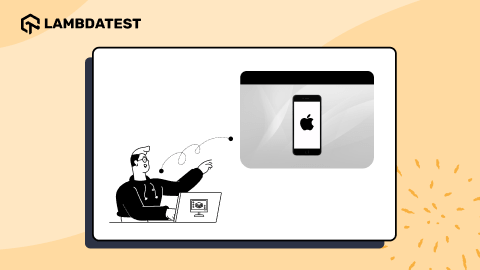Common Screen Sizes: What They Are and How to Test
Harish Rajora
Posted On: November 14, 2024
![]() 53164 Views
53164 Views
![]() 12 Min Read
12 Min Read
Applications are accessed on a wide range of devices globally, but most users in specific regions tend to use devices within certain screen size ranges. These common screen sizes are key to understanding user behavior and optimizing app performance.
To further refine your screen size testing, it’s essential to consider screen resolution, as it directly impacts how your app will appear on different devices.
According to Statcounter, tracking these screen resolutions helps identify the most commonly used configurations, ensuring your app delivers an optimal user experience across popular devices.
TABLE OF CONTENTS
Why Should Testers Focus on Common Screen Sizes?
Testers must aim to consider all users, regardless of device size, for an operation. While this approach might seem ideal in theory, it often leads to excessive resource expenditure with limited returns. Small and medium enterprises can’t afford such costs, so the focus shifts to the screen sizes most commonly used by their users.
Some of the reasons why testers should focus on common screen sizes are mentioned below:
- Better User Experience: Focusing on common screen sizes ensures the application works well for the majority of users, improving overall user satisfaction.
- Helps in Responsiveness: A responsive application adapts to different screen sizes, resolutions, and operating systems. Knowing the common screen sizes helps ensure the app works seamlessly across various devices.
- Understand User Needs: Analyzing common screen sizes allows testers to design the application for the devices most used by their audience, improving the app’s relevance.
- Shift Towards Market Trends: Regular analysis of common screen sizes helps track market shifts and adapt before user preferences change significantly.
- Optimization of Application: Knowing the common screen sizes allows testers to focus on optimizing media elements (images, videos) and other screen-size-dependent features, enhancing the user experience.
By prioritizing common screen sizes, testers can ensure the application is optimized for the majority of users, reducing the risk of negative feedback.
Finding Common Screen Sizes Being Used
To find the common screen sizes, you should incorporate the following methods into the testing cycles:
- Analytics: Analytics reports provide insights into user behavior and usage patterns, including the screen sizes users are using and their respective percentages. This is the most reliable method for identifying common screen sizes.
- Purchase Trends: Analytics only shows past data. To predict future trends, monitor device purchase trends, available through device manufacturers’ official websites. This helps anticipate which devices will become popular.
- Future Device Plans: Keep an eye on manufacturers’ plans for releasing new devices with different screen sizes. This helps ensure the team is prepared for any changes before devices are launched.

By analyzing these three factors, testers can prepare for both current and future scenarios without relying on AI algorithms, which are currently not fully accurate.
Common Screen Sizes for Testing
Understanding common screen sizes is crucial to avoid creating an overly broad range that includes devices with vastly different screen sizes, such as mobile devices with screens up to 9 inches and laptops with screens as large as 17 inches. This makes it important to segregate the common screen sizes into categories before beginning testing.
Common screen sizes can be divided into four categories:
- Mobile Devices: Devices up to 9 inches, including features like SIM card support and call functionality.
- Tablet Devices: Larger than mobile devices with screens ranging from 12 to 13 inches, used mainly for productivity but lacking mobile features like call support.
- Large Screen Devices: Desktops and laptops with screens ranging from 13 to 17 inches.
- Extra Large Screen Devices: Monitors and televisions, which have screens larger than 17 inches.
Screen sizes come in various resolutions that affect the display of visual elements. It actually represents the number of pixels in each size the screen can display.
Here’s an overview of some of the common resolutions associated with different devices and screen sizes:
- Mobile Common Screen Resolutions
- 360×800: Used by 11.28% of mobile devices. Example device: Motorola Moto E7.
- 390×844: Used by 6.9% of devices. Example device: iPhone 12.
- 393×873: Used by 5.57% of mobile screens worldwide. Example device: Xiaomi Redmi Note 10S.
- Tablet Common Screen Sizes
- 768×1024: The most popular tablet size, used by 20.09% of tablets. Example device: iPad Air 2.
- 810×1080: Used by 11.19% of tablets. Example device: Apple iPad 10.2.
- 820×1180: Used by 8% of tablets. Example device: iPad Air 10.
- Desktop Common Screen Sizes
- 1920×1080: The most common desktop screen resolution, used by 24.52% of devices. Example device: Lenovo IdeaPad Slim 1.
- 1366×768: Used by 12.77% of desktops. Example device: Dell Latitude 5420.
- 1536×864: Used by 11.85% of desktops as of 2024. Example device: Dell E2318H.
Testers should treat screen sizes as separate lists, focusing on each individually. This approach helps identify device-specific bugs and ensures responsiveness across relevant screen sizes. Segregating screen sizes allows testers to concentrate on the most important ones for all user types rather than creating a general list.
 Note
NotePerform web and mobile application testing over a wide range of screen sizes and resolutions. Try LambdaTest Today!
Testing on Common Screen Sizes
Collecting all the theoretical information on common screen sizes and the importance of knowing them before testing, the team needs to start the actual testing process.
This takes place in two steps:
- Ensuring Prerequisites are Complete
- Choosing the Testing Method
Ensuring Prerequisites are Complete
Before starting the testing process, ensure the prerequisites are in place. This includes:
- Attaching an analytics and monitoring tool to the application.
- Collecting and analyzing data to identify common screen sizes.
- Considering parameters like geographical locations for more targeted testing.
- Gathering manufacturer details and extracting screen size data for future planning.
Choosing the Testing Method
Once the prerequisites are in place, selecting the right testing method is crucial.
Here are some effective options to choose from:
- Testing on Physical Devices: This testing allows you to test your application directly on physical devices. It also helps in providing an authentic experience of how the application performs on actual devices with specific screen sizes. This method is suitable for in-depth testing of specific devices that may have unique characteristics or issues.
- Testing on Emulators/Simulators: You can use emulators or simulators, which is cost-effective and the most-quick way to test on different screen sizes without needing physical devices.
- Testing on Real Device Cloud: This approach offers you a wide range of real devices with different screen sizes, operating systems, and browser versions. These platforms enable remote testing, saving time and costs associated with maintaining physical devices.
Real device cloud like LambdaTest offers an AI-powered platform ideal for scaling your web and mobile application testing. With LambdaTest, you can perform emulator/simulator and real device testing across 3000+ real devices, browsers, and OS combinations.
Testing Common Screen Sizes on a Real Device Cloud
Real device cloud like LambdaTest allows you to perform mobile automation testing using frameworks like Appium, Espresso and XCUITest. This platform enables efficient testing of both web and mobile applications without the need to maintain physical devices, making it a cost-effective and scalable solution for your testing needs.
Testing the application using real devices on LambdaTest is a fairly easy path to follow.
- Create an account on the LambdaTest platform.
- From the Dashboard, go to Real Device.
- Choose App Testing (or Browser Testing if needed). For mobile app testing, select App Testing.
- Select the device type, either Android or iOS and upload your apk or ipa file.
- Choose the browsers you want to test on, along with the specific device operating system.
- Click Start to begin testing.


The screen is divided into three sections:
- Left Section: Contains specialized testing tools, including geolocation testing, visual testing, screenshot testing, video recording, and more.
- Middle Section: Displays the selected device with the application installed, allowing the tester to operate it just like a physical device.
- Right Section: Shows logs generated during the processes running on the device.
Together, these panels create an efficient testing environment for common screen sizes with minimal effort.
Subscribe to the LambdaTest YouTube Channel for more videos on mobile testing concepts.
Best Practices for Testing Common Screen Sizes
Testing common screen sizes is a specific part of application testing, focusing on certain screen sizes rather than covering all possible ones.
Here are some best practices to help make this process smooth and effective:
- Consider Aspect Ratios: Testing for common screen sizes is more than just checking responsiveness or functionality at a specific resolution. It’s important to test different aspect ratios on each screen size, especially for multitasking or when resizing the app on a device. This is key to ensuring a smooth user experience.
- Use Analytics Regularly: Analytics provides a list of common screen sizes for your app, but these sizes change as user preferences shift. Keeping analytics updated in every testing cycle, even for frequent releases, is a good practice.
- Monitor User Behavior: Monitoring tools give insights into how users interact with your app on different screens. They reveal patterns, like which buttons users click the most on a particular screen size, helping to optimize layouts for a better user experience.
- Test in Both Portrait and Landscape: Testing on a screen size like 360×800 means checking it both in portrait (360×800) and landscape (800×360) orientations.
- Stay Updated on Trends: Monitoring mobile app development trends, device sales, and user surveys helps anticipate changes in popular screen sizes, enabling the team to adapt quickly as new sizes emerge.
- Use Real Devices: While emulators and simulators are useful, they sometimes fall short in areas like network latency. Testing on real devices gives accurate metrics and ensures real-world reliability. Cloud-based tools, such as LambdaTest, offer easy access to real devices.
- Include Accessibility Testing: Accessibility testing ensures that users with disabilities have an optimal experience. Testing for visual, auditory, and motor impairments is both an ethical obligation and a legal requirement for many businesses. Using tools like the Accessibility DevTools Chrome extension can be beneficial for verifying the accessibility of your mobile application.
- Focus on Performance: Performance testing ensures the app meets user expectations. A poor experience can harm the app’s reputation, even if the issue is due to the user’s network or device. Regular performance checks should be part of every release.
Following these general practices helps in testing devices with common screen sizes. Other practices may apply depending on the project, business, or users, so consider these as well for the best results.
Conclusion
The high fragmentation of devices often leaves the testers wondering about their priorities when it comes to screen size. However, determining and testing the most common screen sizes is the best way to make sure the majority of your audience is always satisfied. It does take a few additional steps to be included in the already tight testing cycles, but the returns are exceptional.
This post navigates through the concept of common screen sizes and explores the methods through which we can identify these sizes for each of our applications. Once this is achieved, the testers can follow any of the two testing methods included with some of the best practices described in the previous sections. With this, we believe that while common screen sizes have been observed for a long time to reorganize the application development, they should be an integral part of testing determining the shifting trends and priorities of the testers.
Frequently Asked Questions (FAQs)
What is the most commonly used screen size?
The most common screen size depends upon the device in consideration. The following is a combined list of common screen sizes across mobile devices, tablets, and desktops.
- 1920×1080
- 360×800
- 768×1024
- 1366×768
- 390×844
What is the most common desktop size?
Mobile testing involves testing applications on mobile devices for functionality, usability, and performance. This includes testing native, web and hybrid mobile apps.
What is the most common mobile size?
The most common mobile size is 360×800 used by 11.28% of all the mobile users.
Got Questions? Drop them on LambdaTest Community. Visit now














